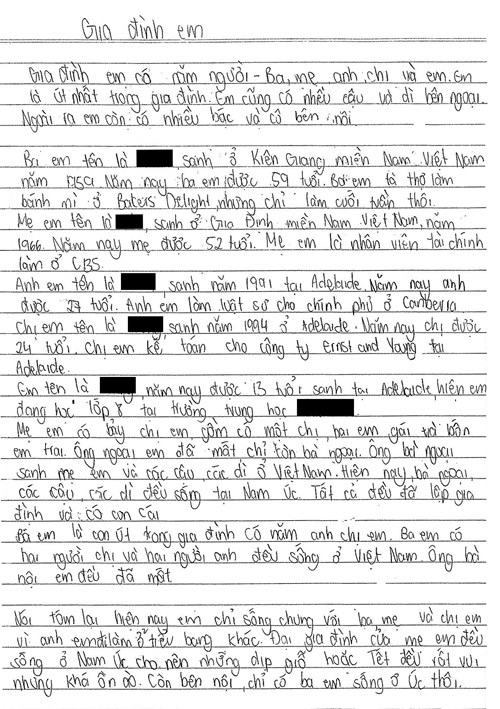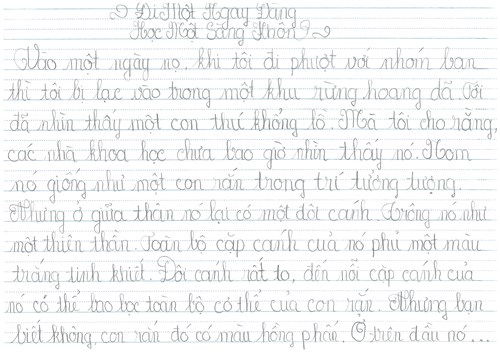By the end of Year 8, students use written and spoken Vietnamese to interact with peers and the teacher to exchange personal information (for example, Em tên Nam. Em mười hai tuổi. Em sinh ở Úc), describe feelings (for example, Em vui/hạnh phúc) and express preferences (for example, Em thích chơi thể thao. Em thích ăn phở hơn hủ tíu). When participating in collaborative activities and classroom routines, they use modelled language to complete transactions, to ask and respond to questions (for example, Bạn học trường nào? Gia đình tôi có bốn người), to follow instructions (for example, Các em hãy chú ý/ chép bài này vào tập!), to request support and permission (for example, Xin cô vui lòng lặp lại/giải thích chữ này. Thưa thầy/cô, cho em đi vệ sinh), and to make arrangements (for example, Thứ Bảy này mình đi coi phim nha). When interacting, they use the features of the sound system, including tones, to pronounce words and expressions, and form affirmative (for example, Em ăn cơm), negative (for example, Em không ăn cơm), interrogative (for example, Em ăn cơm không?) and imperative (for example, Ăn cơm đi!) sentences. Students locate specific information in a range of texts and present information and ideas related to personal, social and natural worlds in spoken, written and digital forms using modelled language structures. They share their responses to a range of imaginative texts by identifying and describing key elements and expressing opinions. They create or adapt familiar imaginative texts for a range of audiences, using common adverbs of sequence such as trước hết, kế đến and sau cùng to organise and link ideas. They use personal pronouns (for example, tôi, bạn, em, con, anh, chị, cô, ông, bà), nouns (for example, bạn, học sinh, thầy giáo, cô giáo, cha mẹ, cái bàn, cây viết, con chó, trái cam), adjectives (for example, già, trẻ, lớn, nhỏ, tốt, hiền, thông minh, chăm chỉ), verbs (for example, ăn, uống, ngủ, nói, đọc, học, chạy, đi bộ), adverbs (for example, hay, giỏi, nhanh, chậm) and conjunctions (for example, và, hay, vì, nhưng). They apply rules of the Vietnamese writing system to spell familiar words, including tone markers. They translate and interpret short texts, identifying words that are not easily translated, such as cúng, bánh chưng/bánh tét, and create bilingual texts to support their own learning and for the school community. They compare ways of communicating in Vietnamese and English and explain how their own biography influences their cultural identity and ways of communicating.
Students identify the tones of spoken and written Vietnamese. They identify Vietnamese sound–letter relationships, the formation of consonants clusters (for example, ch, nh, th, tr, ph), diphthongs (for example, ai, ao, au), triphthongs (for example, oai, ươi), and vowel–consonant combinations such as an, am, ac, at. They compare the structural and language features of Vietnamese and English in personal, informative and imaginative texts, identifying audience and purpose. They describe how language use varies according to setting and context. Students provide examples of how the Vietnamese language has changed over time, identifying Vietnamese words that have emerged through contact with other languages, for example, cà rốt, cà phê, căn-tin. They identify cultural practices that are embedded in language use and communication styles, such as use of the terms dạ/thưa to express politeness and respect.






